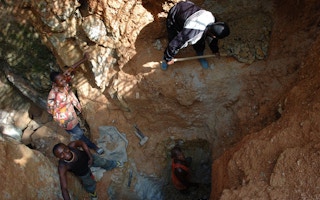Apple’s recent interest in buying cobalt directly from miners has spurred renewed interest in the metal. Cobalt prices have quadrupled since hitting an all-time low just two years ago. Cobalt’s use in the rechargeable batteries of electric cars and smartphones triggered a spike in the market and demand isn’t expected to slow. In fact, if you are reading this article online, you’re probably using a device containing cobalt.
Unfortunately, supply chain practices haven’t kept at pace with demand. While Apple has received high marks for improving on past revelations of disreputable practices, the company remains an outlier in an industry with a rapidly growing appetite for cobalt. Little if any action has been taken by many global tech companies to address the most insidious elements of cobalt sourcing.
Software and systems can now trace supply chains from end-to-end, even in the most remote areas, making it possible to ensure that cobalt is sourced conflict-free. Companies no longer have an excuse for not knowing the source of their materials.
Most corporations lack visibility of their cobalt supply chain beyond the smelters that purchase the ore from mines, or intermediaries. Many brands report that they rely on these smelters to abide by legal and company guidelines, even when there is little reason to trust they are doing so. Other companies admit to flaws in their supply chain, but claim it is simply unrealistic to untangle the chaotic materials mixing that occurs in and around the mines, particularly in the Democratic Republic of the Congo (DRC), which produces 60 per cent of the world’s cobalt.
“
As more companies utilise technology to account for their supply chain, transparent sources will be considered more valuable, and unaccounted for mines would be isolated, or incentivised to end high-risk and inhumane practices.
In 2016, Amnesty International issued a groundbreaking report on the multi-national companies sourcing their cobalt from the DRC’s labyrinth of mines. An estimated one-fifth of that production occurs in so-called “artisanal” mines, which operate with little oversight and are blighted by stories of collapsing shafts and harsh work environments for the nearly 150,000 workers. These mining operations are also supplemented by the backbreaking work of an estimated 40,000 child laborers who are cheated out of pay, vulnerable to harm, and often handle the toxic material without gloves or masks.
Companies pledged to make necessary changes in response to the findings, but in a follow-up report released at the end of last year, Amnesty International reported that nearly every manufacturer was still lagging in their efforts to mitigate risk and address human rights violations in their supply chain. The report stated, “…companies in all downstream sectors are failing to meet minimal expectations when it comes to investigating human rights risks.” It further described most companies as, “largely in the dark” regarding if, and to what extent, their cobalt comes from troubled sources.
Cobalt certainly poses one of the most challenging sourcing environments. However, solutions do exist. Increasingly available technology and techniques give companies the ability to trace 100 per cent of their materials from the source.
The process starts by deploying mobile devices with easy-to-use apps to every mine. As each bag of ore is filled, it is tagged, barcoded and scanned. GPS-linked data points about the bag’s origin, weight and contents are recorded. Even photos of the bag and miner who filled can be uploaded.
After the bag leaves the mine - and at every point the bag changes hands from truck drivers to the smelters - the tag is rescanned, and the information verified. When mines and transportation routes are out of reach of the internet, the app stores the information until it can be automatically synced to a database once the device is brought within range.
Existing cloud-based traceability software is capable of managing, sorting and analyzing the data recorded at every point along the chain of custody. For an added layer of security, Blockchain technology can keep the transaction data secure by storing it only on each participant’s device.
Cloud-based traceability databases and Blockchain-based distributed ledgers could enable supply chain managers to track the path the cobalt travels, who handles it and when. The data points will tell companies if their cobalt is originating from troublesome mines, traveling through areas associated with armed rebel groups, or if any mines are producing or transporting unrealistic loads, suggesting potential material smuggling, child labor, and other high-risk activities.
As more companies utilize technology to account for their supply chain, transparent sources will be considered more valuable, and unaccounted for mines would be isolated, or incentivized to end high-risk and inhumane practices.
The DRC is set to raise the royalties charged to cobalt mines, which will likely trigger higher prices in an already surging market. Rising costs will only reduce manufacturers’ motivation to root out cheaper, higher-risk sources. We cannot tolerate corporate inaction in the face of such atrocities. And smart brands will not take that risk.
Dr. Leonardo Bonanni is a supply chain traceability and transparency advocate, entrepreneur and designer. He is the founder and CEO of the supply chain mapping platform, Sourcemap.


















